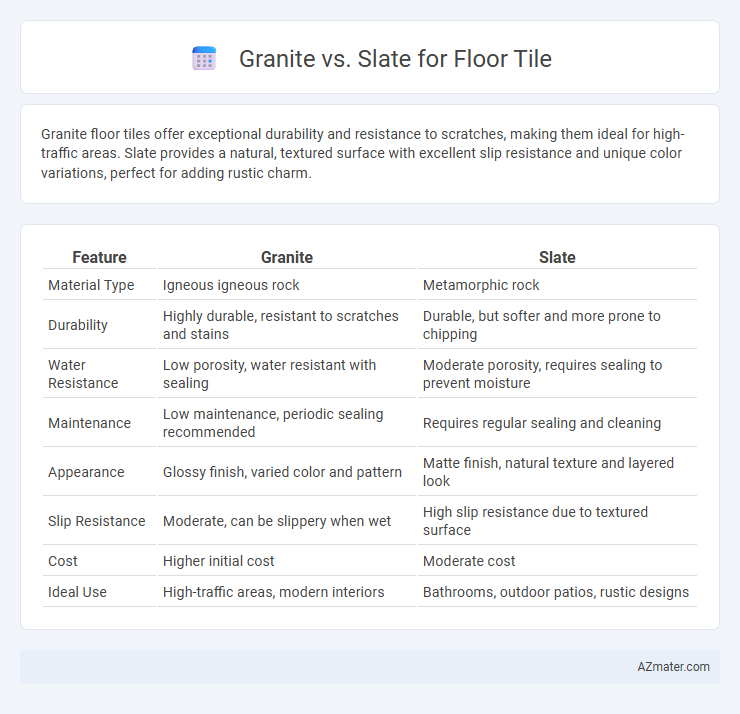Granite floor tiles offer exceptional durability and resistance to scratches, making them ideal for high-traffic areas. Slate provides a natural, textured surface with excellent slip resistance and unique color variations, perfect for adding rustic charm.
Table of Comparison
| Feature | Granite | Slate |
|---|---|---|
| Material Type | Igneous igneous rock | Metamorphic rock |
| Durability | Highly durable, resistant to scratches and stains | Durable, but softer and more prone to chipping |
| Water Resistance | Low porosity, water resistant with sealing | Moderate porosity, requires sealing to prevent moisture |
| Maintenance | Low maintenance, periodic sealing recommended | Requires regular sealing and cleaning |
| Appearance | Glossy finish, varied color and pattern | Matte finish, natural texture and layered look |
| Slip Resistance | Moderate, can be slippery when wet | High slip resistance due to textured surface |
| Cost | Higher initial cost | Moderate cost |
| Ideal Use | High-traffic areas, modern interiors | Bathrooms, outdoor patios, rustic designs |
Introduction to Granite and Slate Floor Tiles
Granite floor tiles are renowned for their exceptional hardness and durability, making them ideal for high-traffic areas due to their resistance to scratches and stains. Slate floor tiles offer a unique natural texture and a slightly cleft surface that provides slip resistance, along with a wide range of earthy colors from gray to green and rust. Both materials are prized for their longevity and aesthetic appeal, with granite often chosen for its polished finish and slate favored for its rustic, matte appearance.
Key Differences Between Granite and Slate
Granite floor tiles are igneous rocks known for their durability, high hardness rating of 6-7 on the Mohs scale, and a polished, glossy finish that resists stains and scratches. Slate tiles, a metamorphic rock with a Mohs hardness of 3-5, have a naturally cleft, textured surface that offers slip resistance but requires more maintenance due to its porous nature. While granite is favored for high-traffic areas and outdoor use due to its strength and low absorption, slate is preferred in spaces seeking a rustic or natural aesthetic with moderate durability.
Aesthetic Appeal: Granite vs Slate
Granite flooring offers a polished, glossy finish with a wide range of colors and speckled patterns that enhance modern and luxurious spaces. Slate provides a natural, textured surface with earthy tones and unique layering, contributing to a rustic or contemporary aesthetic. The choice between granite and slate flooring depends on desired visual impact and maintenance preferences, with granite favoring elegance and slate emphasizing organic beauty.
Durability and Longevity Comparison
Granite offers exceptional durability due to its high density and resistance to scratches, making it ideal for high-traffic floor areas. Slate, while also durable, features natural clefts that can be prone to chipping or flaking under heavy impact. Both materials provide long-lasting flooring solutions, but granite typically outperforms slate in maintaining structural integrity over extended periods.
Installation Process and Complexity
Granite floor tile installation requires precise cutting tools due to its hardness, making the process more labor-intensive and time-consuming compared to slate. Slate tiles are softer and more flexible, allowing for easier handling and simpler cutting, which typically reduces installation complexity. Both materials need a solid, level substrate and proper sealing, but granite's dense composition demands professional expertise for optimal results.
Maintenance Requirements and Tips
Granite floor tiles require regular sealing every 1 to 2 years to prevent staining and moisture infiltration, while slate tiles need resealing every 2 to 3 years to maintain their natural texture and prevent water damage. Both materials benefit from routine cleaning with pH-neutral cleaners to avoid surface etching or grout deterioration. Avoid harsh chemicals and abrasive tools on granite and slate floors to preserve their finish and longevity.
Cost Analysis: Granite vs Slate
Granite floor tiles typically cost between $5 and $10 per square foot, reflecting their durability and natural beauty, while slate tiles range from $4 to $9 per square foot, offering an affordable yet aesthetically appealing alternative. Installation costs for both materials vary, with slate sometimes requiring more specialized labor due to its cleavage planes, potentially increasing expenses by up to 15%. Maintenance and longevity factors influence overall value, as granite's high resistance to scratches and stains can reduce long-term costs compared to slate, which may require sealing every few years to maintain its appearance.
Best Applications for Each Material
Granite floor tiles are best suited for high-traffic areas such as kitchens and hallways due to their exceptional durability, resistance to scratches, and ability to withstand heavy foot traffic. Slate tiles excel in moisture-prone spaces like bathrooms and outdoor patios because of their natural slip resistance and water-resistant properties. Both materials offer unique aesthetic benefits, with granite providing a polished, glossy finish and slate delivering a textured, rustic look ideal for creating visually striking floors.
Environmental Impact and Sustainability
Granite floor tiles, quarried from natural stone, have a moderate environmental impact due to energy-intensive extraction and processing but offer long-term durability, reducing replacement frequency and waste. Slate tiles, also natural stone, generally require less energy to extract and produce, making them a more sustainable choice with a lower carbon footprint and excellent recyclability. Both materials are eco-friendly compared to synthetic alternatives, but slate's minimal processing and longevity enhance its overall sustainability profile for flooring applications.
Choosing the Right Floor Tile for Your Space
Granite offers exceptional durability and resistance to scratches, making it ideal for high-traffic areas and kitchens, while slate provides a natural, textured surface with excellent slip resistance suited for bathrooms and outdoor spaces. Both materials vary in color and finish, with granite typically exhibiting a polished shine and slate presenting a more rustic, matte appearance that adds character to any room. Considering factors like maintenance requirements, moisture exposure, and desired aesthetic helps determine whether granite's strength or slate's natural texture is the optimal choice for your floor tile needs.

Infographic: Granite vs Slate for Floor Tile
 azmater.com
azmater.com